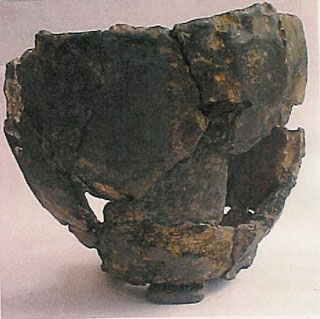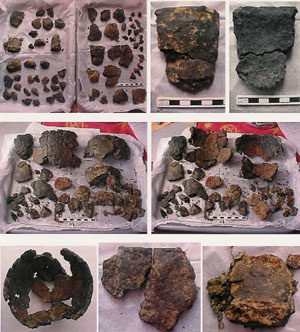
The Mellor Pot

In 2001 however Mellor produced pottery from several Iron Age contexts, with Trench 15 in particular producing 125 sherds of pottery belonging to the same Iron Age pot. These were conserved and the pot reconstructed and have now become known as The Mellor Pot.
This was considered to be very important as the problem in associating Mellor with other Iron Age sites in the region had been the lack of material culture which had been found, making previous attempts to establish a sequence of pottery types almost impossible.
 Where did it come from
Where did it come fromThe petrographic analysis of the Mellor Pot suggested a relatively local source for this particular vessel ( and others sharing the same fabric)
Extract from Conservation Report
"The vessel consisted of approximately 125 sherds in fairly stable condition although several had laminating surfaces. The fabric was light-dark brow/black in colour to its outer surface and patchy dark red/brown over most of its interior".
 How was it made
How was it made"Fingermarks were visible around the rim of the vessel, giving a 'dimpled' appaerance where it had been squeezed or pinched and these may be partly decorative. The vessel was hand built and the walls were uneven in thickness. The outer surface had been smoothed, a process which gave a roughly burnished appearance to the finished vessel."
X-Radiographic examination
The vessel sherds were x-rayed ( at 100kvp for 1-1.5 mins) to see if this would aid the process of reconstruction. Unfortunately, this was not the case but the x-rays revealed that the vessel was tempered with an array of inclusions varying widely in density and size.
How was it conserved
The sherds were carefully cleaned with a soft brush to remove any loose soil, prior to being stuck with HMG Paraloid B72 adhesive ( methyl methacrylate copolymer in a solvent base). It was decided not to consolidate, since most of the fragments appeared to be strong. Where the surface was spalling away on some sherds, it was repaired using the above adhesive.
Although much of the vessel was missing, particularly around the rim and central body area, it was possible to reconstruct a basic profile suitable for display.
With Thanks to Alison Walster
